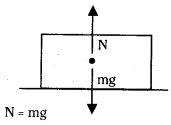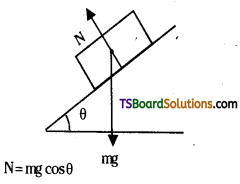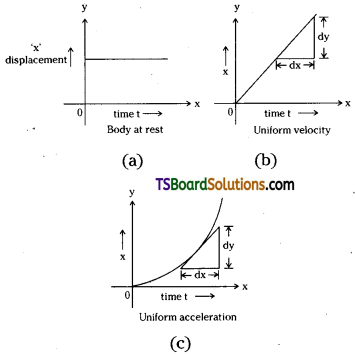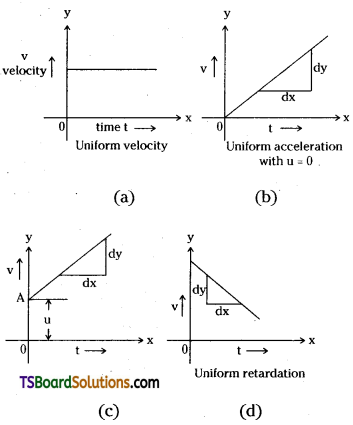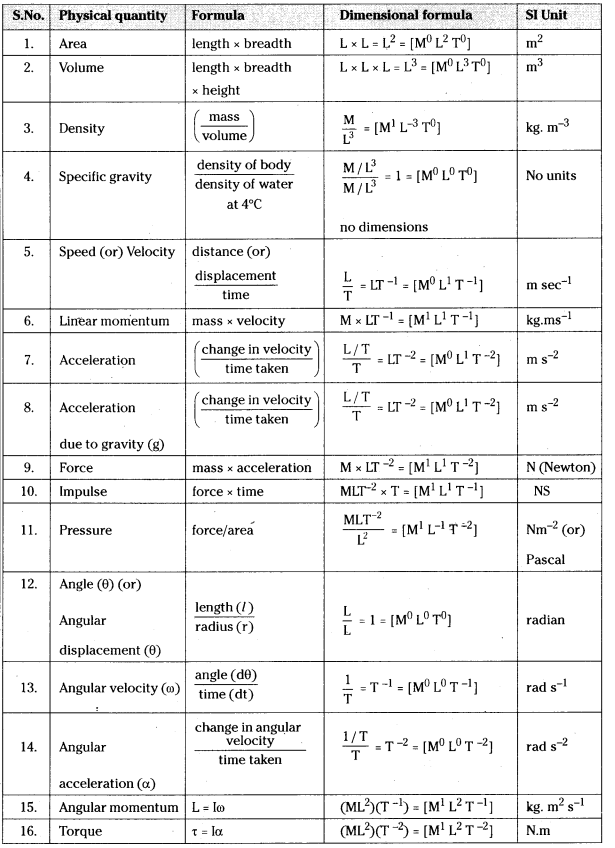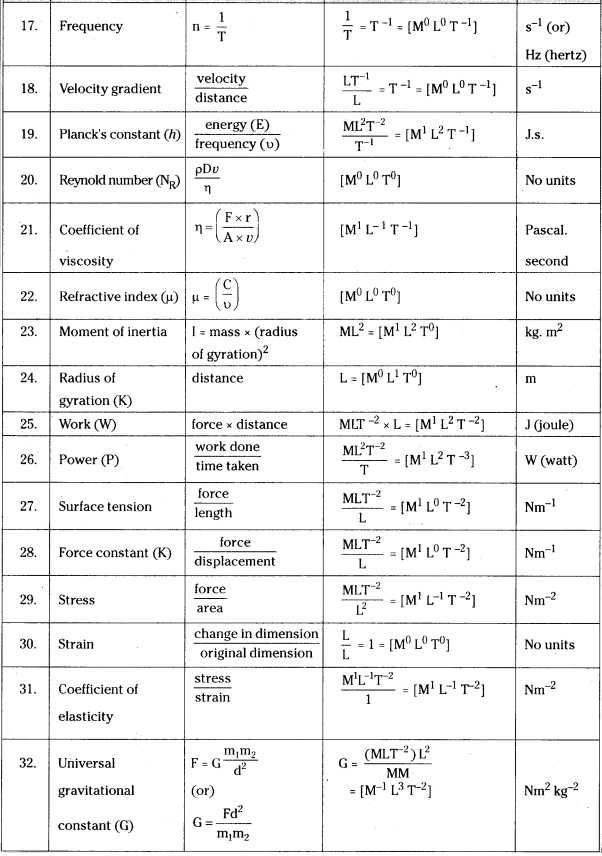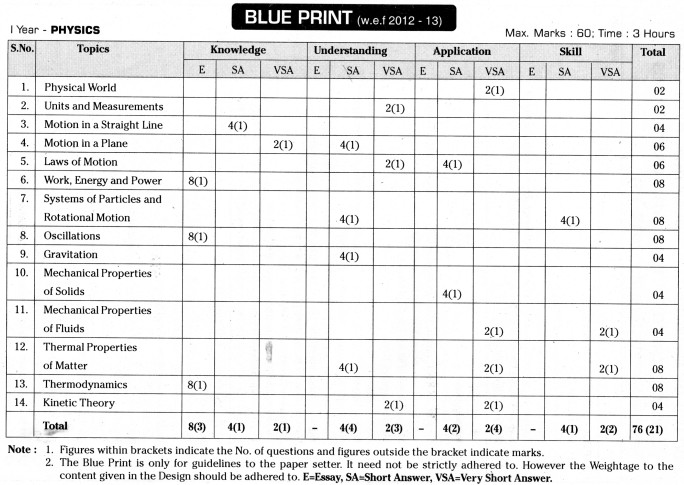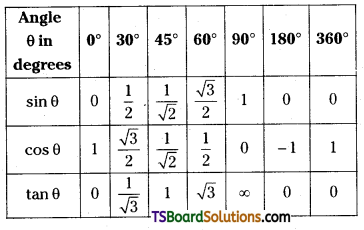Here students can locate TS Inter 1st Year Physics Notes 12th Lesson Thermal Properties of Matter to prepare for their exam.
TS Inter 1st Year Physics Notes 12th Lesson Thermal Properties of Matter
→ Temperature: Temperature is a relative measure of hotness or coldness of a body.
→ Heat: Heat is a form of energy transferred between two systems and its surroundings by virtue of temperature difference.
→ Measurement of temperature: Thermometers are used to measure temperature. Commonly used property in measuring temperature is variation of volume of a liquid with temperature.
Since temperature is a relative concept- two fixed points are used for standard scale. They are
- Freezing point of pure water is taken as “lower fixed point”.
- Boiling point of pure water at standard atmospheric pressure is taken as “upper fixed point”.
→ Celsius scale (°C): In Celsius scale freezing point of water at standard atmospheric pressure is taken as zero. Boiling point of water at standard atmospheric pressure is taken as 100. The temperature difference between these two limits is divided into 100 equal parts and each part is called as 1°C.
→ Fahrenheit scale (°F): In Fahrenheit scale, freezing point of water is taken as 32 °F and boiling point of water is taken as 212 °F. The temperature difference between these two limits is divided into 180 equal parts. Each part is called 1 °F.
Note: Relation between Celsius scale and
Fahrenheit scale is \(\frac{\mathrm{T}_{\mathrm{F}}-32}{180}=\frac{\mathrm{T}_{\mathrm{c}}}{100}\)
→ Boyle’s Law: When temperature is held constant, volume of a given mass of gas (V) is inversely proportional to its pressure (P)
i.e., V ∝ \(\frac{1}{P}\) ⇒ PV = constant.

→ Charles’ Law (I): When pressure is kept constant, the volume of a given mass of gas (V) is proportional to the temperature (T).
i.e., V ∝ T ⇒ \(\frac{P}{T}\) = constant
→ Charles’ Law (II): When volume is constant the pressure of a given mass of gas (P) is proportional to the temperature (T).
i.e., P ∝ T ⇒ \(\frac{P}{T}\) = constant
→ Ideal gas equation: From Boyle’s law for given quantity of gas PV = constant. From Charles’ law \(\frac{V}{T}\) is constant for given quantity of gas. By combining these two laws, \(\frac{PV}{T}\) = constant for given quantity of gas.
i.e., \(\frac{PV}{T}\) = nR or PV = nRT
Where n = Number of gram moles of gas taken,
R = Universal gas constant = 8.31 J mole-1. K-1.
Note: The temperature’T’ used in Charles’ law and in ideal gas equation is absolute scale or Kelvin scale of temperature.
→ Kelvin scale or Absolute scale of temperature: The temperature scale in which -273.15 °C is taken as the zero point (‘0’K) is called”Kelvin scale or absolute scale of temperature.”
The size of unit in Kelvin scale and in Celsius scale are equal. A relation between them is T = tc + 273.15.
Note: The temperature scales of Kelvin and Celsius does not coincide numerically. Whereas the magnitudes of Celsius scale and Fahrenheit scales are numerically equal at – 40 i.e., – 40 °F = – 40 °C.
→ Thermal expansion: Most substances expand on heating and contract on cooling.
The increase in the dimensions of a body per unit dimension due to increase in temperature is called Thermal expansion.
Note:
- Expansion in length is called linear expansion.
- Expansion in area is called areal expansion.
- Expansion in volume is called volume expansion.
→ Linear expansion coefficient or coefficient of linear expansion (α): For a body in the form of a rod the fractional change in length \(\frac{\Delta l}{l}\) is proportional to change in temperature ΔT.
i.e., \(\frac{\Delta l}{l}\) ∝ ΔT ⇒ \(\frac{\Delta l}{l}\) = αΔT
α = \(\frac{\Delta l}{l \cdot \Delta \mathrm{T}}\) ⇒ α = \(\frac{l_2-l_1}{l_1\left(\mathrm{t}_2-\mathrm{t}_1\right)}\)/°C
Where α = coefficient of linear expansion.
→ Coefficient of areal expansion (αa): For a body in the form of thin sheet fractional increase in area (Δa/a) is proportional to change in temperature (ΔT).
i.e., \(\frac{\Delta a}{a}\) ∝ ΔT ⇒ \(\frac{\Delta a}{a}\) = αaΔT ⇒ αa = \(\frac{a_2-a_1}{a_1 \Delta T}\)/°C
Where αa = coefficient of areal expansion.
→ Coefficient of volume expansion (αv): For a body the fractional change in volume ( ΔV/V) is proportional to change in temperature ΔT .
i.e., \(\frac{\Delta V}{V}\) ∝ ΔT (or) \(\frac{\Delta V}{V}\) = αVΔT ⇒ αv = \(\frac{\Delta \mathrm{V}}{\mathrm{V} \cdot \Delta \mathrm{T}}\)/°C
(or) coefficient of volume expansion
αv = \(\frac{V_2-V_1}{V_1\left(t_2-t_1\right)}\)/°C

→ Relation between expansion coefficients α, αa and αv: Coefficient of areal expansion αa = 2a
Coefficient of volume expansion αv = 3α
→ Thermal stress: When a body is heated and expansion is prevented then stress will develop in the body. This is known as Thermal stress.
When a body is heated fractional increase in length Δl/l = αAT.
But from principles of elasticity Δl/l is strain.
Young’s modulus Y = \(\frac{\text { stress }}{\text { strain }}=\frac{F / A}{\Delta l / l}\)
Stress produced = Y . Δl/l. This is called thermal stress.
→ Anomalous expansion of water: Water when heated from 0°C to 4 °C its volume will decreases and4°-100°Cits volume increases. This phenomenon is called “Anomalous expansion of water.”
Note: Due to anomalous expansion water has maximum density at 4 °C.
→ Importance of anomalous expansion of water: Due to anomalous expansion of water in polar region and in cold countries water freezes from the top layers of lakes or rivers etc. But water will exist at 4 °C at bottom layers. Hence aquatic life such as plants, fishes etc., are able to survive at bottom layers even in winter.
→ Heat capacity (S): It is the quantity of heat required by a substance to change its temperature by one unit.
Heat capacity
S = \(\frac{\text { Heat supplied }}{\text { Change in temperature }}=\frac{\mathrm{dQ}}{\mathrm{dt}}\)
Unit: joule/kelvin ; D.F = ML2T-2K-1
→ Specific heat (s): The amount of heat absorbed or rejected to change the temperature of unit mass of a body by one unit temperature difference is called “specific heat.”
Specific heat s = \(\frac{\mathrm{S}}{\mathrm{m}}=\frac{1}{\mathrm{~m}} \cdot \frac{\mathrm{dQ}}{\mathrm{dt}}\)
Unit: joule kg-1 k-1; D.F = L2T-2 K-1
→ Molar specific heat: Heat capacity of substance per mole of substance is called “Molar specific heat.”
Molar specific heat C = \(\frac{S}{n}=\frac{1}{n} \frac{d Q}{d T}\)
Unit: joule/mole – kelvin (or) joule, mole-1 kelvin-1; D.F = ML2T-2 mol-1 K-1
Note: Since volume and pressure of a gas depend much on temperature, we have two molar specific heats for gases.
- Molar specific heat at constant pressure (CP) The amount of heat required to raise the temperature of one gram mole of gas through 1 °Cor T K at constant pressure.
- Molar specific heat at constant volume (Cv): The amount of heat required to raise the temperature of one mole of gas through 1 °C or 1 Kelvin at constant volume.
Note: In gases CP > Cv. When a gas is heated at constant volume all the heat energy supplied is useful to rise the temperature of the gas only. Whereas when a gas is heated at constant pressure heat energy supplied is useful to increase the temperature of the gas and also to do external work.
→ Principle of calorimetry: In a thermally isolated system, when a hot body and cold body are mixed together then “Heat lost by hot body = Heat gained by cold bodyThis is called “principle of calorimetry”.
→ Change of state: The transition from one state to another state of matter is called “change of state”.
Ex: Conversion of a solid into liquid (or)
Conversion of a liquid into vapour or vice versa.

→ Melting point: Change of state from solid to liquid is called “melting point”.
At melting point temperature of solid and liquid forms are in thermal equilibrium. Temperature of the liquid does not increase until the whole solid is converted into liquid.
→ Normal melting point: Melting point at standard atmospheric pressure is called “normal melting point”.
→ Vaporisation: The change of state from liquid to vapour (or gas) is called vaporisation.
→ Boiling point: The temperature at which the liquid and vapour states of a substance coexist is called “boiling point”.
At boiling point temperature of the vapour does not increase until the whole liquid is converted into vapour.
→ Effect of pressure on boiling point:
- The boiling point of a liquid increase when pressure increases.
- The boiling point of a liquid decreases when pressure decreases.
→ Normal boiling point: Boiling point of a liquid at standard atmospheric pressure is called “normal boiling point”.
→ Sublimation: The change from solid state to vapour state without passing through liquid state is called “sublimation”.
Ex: Dry ice (solid CO2), Iodine.
Note: In sublimation when solid is heated it will directly convert into vapour state.
→ Regelation: The process of conversion of a solid into liquid due to increased pressure and again refreezing into a solid when pressure is reduced is called “regelation”.
→ Triple point: The temperature and pressure where a substance can coexist in all its three states, i.e., The substance will exist as a solid, as liquid and as vapour at that particular temperature and pressure.
For water the triple point is at a temperature of 273.16K and at a pressure of 6.11 × 10-3 atmospheres or nearly 610 pascals.
→ Latent heat (L): The amount of heat absorbed or rejected by unit mass of substance while converting from one state to another state at constant temperature.
Latent heat (L) = \(\frac{\text { Heat absorbed } / \text { rejected }}{\text { Mass of the substance }}=\frac{Q}{\mathrm{~m}}\)
→ Latent heat of fusion (Lf): The amount of heat absorbed or rejected by unit mass of substance while converting from solid to liquid or liquid to solid state.
L = 80 cal / gm
→ Latent heat of vaporisation (Lv): The amount of heat absorbed or rejected by unit mass of substance while converting from liquid to vapour or vapour to liquid states.
L = 540 cal / gm
→ Heat transfer: The transmission of heat energy from one system to another system or from one part of the system to another part is known as heat transfer.
Note: Heat transfer will take place in three different methods called
- Conduction,
- Convection,
- Radiation.

→ Convection: It is a process of heat transfer by actual motion of matter. Convection takes place in fluids (i.e., in liquids and gases).
→ Natural convection: In natural convection gravity plays an important part.
When a fluid is heated it will expand, its density will decrease. So it goes to upper layers. Fluid with high density will come down due to gravity. In this way heat energy is transmitted.
→ Forced convection: In forced convection the fluid is forced to move with the help of a pump or by some other mechanism.
Ex: Blood circulation in human body.
→ Trade winds: Trade wind is a result of natural convection.
Due to natural convection a steady surface wind blows on earth in North-east direction towards equator. This is called trade wind.
Note: At equator, temperature is high, so a is heated and goes up. At poles temperature is less, so air is cooled and it will blow towards equator. But due to rotation of earth this air cycle is not exactly between poles and equator. But hot air reaches earth at 30° north to poles and returns to equator.
→ Radiation: In radiation heat energy transfer takes place without any medium. Heat radiation takes place in the form of electromagnetic waves. They do not require any medium to travel.
Ex: Heat energy from Sun reaches Earth in the form of radiation.
Note: Amount of heat energy radiated depends on colour of the body, temperature of the body and its surface area.
→ Black body radiation: An ideal black body will radiate all the heat energy given to it. Thermal radiation of black body at any given temperature is a continuous spectrum which contains electromagnetic waves of different wave lengths.
→ Wein’s displacement law: From Wein’s law, the wave length λm corresponding to maximum energy radiated will decrease with increasing temperature of the body.
From Wein’s law λmT = constant (b)
Wein’s constant b = 2.9 × 10-3 mK
Note: In the solar spectrum λm = 4753 Å. It indicates that surface temperature of Sun is T = 6060 K.
→ Stefan-Boltzmann’s law: The energy emitted per unit time from a hot bodv L ∝ AT4 Where A is area of the body and T is temperature in Kelvin scale, or H = σAT4. Where σ is a constant. It is called Stefan – Boltzmann’s constant, a = 5.67 x 10-8m2K-4.
Note:
- For a body other than black body from Stefan – Boltzmann’s law H = AeσT-4
Where e = emissivity of the body. - If the body is surrounded by a medium of temperature Ts then H = Aeσ(T-4 – Ts-4)
→ Green house effect: Earth will absorb heat radiation and reradiate heat energy of longer wave length. This longer wave length heat radiation is reflected back to earth due to green house gases such as Carbondioxide [CO2], Methane (CH4), Chloroflurocarbons, Ozone (O3) etc. As a result temperature of earth’s atmosphere is gradually increasing. This is known as “green house effect.”
Note: CO2, CH4, Chloroflurocarbons, Ozone (O3) which reflect back longer radiation to earth are called “green house gases”.

→ Global warming: Earth receives heat energy during day time from sun. It reradiates heat energy in the form of longer electromagnetic waves.
But due to presence of green house gases the longer electromagnetic waves were reflected back to earth. As a result temperature of earth’s atmosphere is gradually increasing.
This process will increase with the increased content of green house gases in atmosphere. As a result temperature of earth’s atmosphere increases gradually.
→ Newton’s law of cooling: From Newton’s law of cooling the rate of loss of heat (-dQ/ dt) of a body is directly proportional to the difference of temperature (ΔT = T2 – T1) of the body and the surroundings.
This law holds good when ΔT = T2 – T1 is small.
\(-\frac{\mathrm{d} Q}{\mathrm{dt}}\) (T2 – T1) or \(\frac{\mathrm{d} Q}{\mathrm{dt}}\) = K(T2 – T1)
Where K = constant that depends on area and nature of the body.
→ Relation between Celsius and Fahrenheit scales is \(\frac{C-0}{100}=\frac{F-32}{180} \Rightarrow \frac{C}{5}=\frac{F-32}{9}\)
C = \(\frac{5}{9}\)(F – 32) or F = \(\frac{9}{5}\)C + 32
→ Linear expansion coefficient or Final length,
(α) = \(\frac{l_2-l_1}{l_1\left(t_2-t_1\right)}\)/°C
or Final length, l2 = l1[1 + α(t2 – t1)] or l2 = l1(1 + αΔt)
Increase in length, l2 – l1 = l = l1α(t2 – t1) or l = l1αΔt
→ Areal expansion coefficient
(αa) = \(\frac{A_2-A_1}{A_1\left(t_2-t_1\right)}\)/°C
Final Area (A2) = A1 [(1 + β(t2 – t1)] or A2 = A1 (1 + βΔt)
Increase in area (A2 – A1) = ΔA
= A1 α (t2 – t1) or ΔA = AβΔt
→ Volume expansion coefficient,
(γ) = \(\frac{V_2-V_1}{V_1\left(t_2-t_1\right)}\)/°C
Final volume (V2) = V1 [1 + γ(t2 – t1)] or V2= V1 (1 + γΔt)
Increase in volume = (V2 – V1) = ΔV
= V1 γ (t2 – t1) or ΔV = V1γ Δt

→ Relation between α, αa and αv is αa = 2a, αv = 3a (or) α: αa: αv = 1: 2: 3
→ Change of density with temperature,
ρt = ρ1[1 + αv (t2 – t1)] or ρt = ρ1(1 + αvΔt)
→ Two different metal rods will always keep the same length difference at all temperatures if l1 α2 = l2 α2
→ The volume of unoccupied portion of liquid in a vessel will always remain constant at all temperatures if V1αv1 = V2αv2
→ Volume expansion coefficient of a gas,
α = \(\frac{V_t-V_0}{V_0 t}\)/°C or α = \(\frac{V_2-V_1}{V_1 t_2-V_2 t_1}\)/°C
→ Pressure coefficient of a gas,
β = \(\frac{P_t-P_0}{P_0 t}\)/°C or β = \(\frac{\mathrm{P}_2-\mathrm{P}_1}{\mathrm{P}_1 \mathrm{t}_2-\mathrm{P}_2} \mathrm{t}_1\)/°C
→ In gases, volume coefficient (α) = pressure coefficient (β) = \(\frac{1}{273}\)
→ From Boyle’s law at constant temperature V ∝ \(\frac{1}{P}\) or PV = constant or P1V1 = P2V2
→ From Charle’s Law at constant pressure
V ∝ T or \(\frac{V}{T}\) = constant or = \(\frac{V_1}{T_1}=\frac{V_2}{T_2}\)
→ From Charle’s Law at constant volume
P ∝ T or \(\frac{P}{T}\) = constant or \(\frac{\mathrm{P}_1}{\mathrm{~T}_1}=\frac{\mathrm{P}_2}{\mathrm{~T}_2}\)
→ Ideal gas equation PV = RT for one mole PV = nRT for n moles of gas or
PV = \(\left(\frac{\mathrm{m}}{\mathrm{M}}\right)\)RT
→ Gas equation in terms of mass of gas is
PV = mrT where r = R/M.
→ Universal gas constant,
R = \(\frac{\mathrm{PV}}{\mathrm{T}}\) = 8.317 J / mole – k
→ Rate of flow of heat energy, \(\frac{Q}{t}\) ∝ A\(\frac{\left(\theta_2-\theta_1\right)}{\mathrm{d}}\)
or \(\frac{Q}{t}\) = KA\(\frac{\left(\theta_2-\theta_1\right)}{\mathrm{d}}\)
→ Coefficient of thermal conductivity,
K = \(\frac{\mathrm{Qd}}{{At}\left(\theta_2-\theta_1\right)}\) Unit of K is w/m-k

→ Temperature difference across the ends of a conductor (θ2 – θ1) = \(\left(\frac{\mathrm{Q}}{\mathrm{t}}\right) \frac{\mathrm{d}}{\mathrm{KA}}\) where \(\frac{\mathrm{d}}{\mathrm{KA}}\) = R is known as thermal resistance.
→ When two conductors are joined in end to end, total thermal resistance R = (R1 + R2)
∴ R = \(\left[\frac{\mathrm{d}_1}{\mathrm{~K}_1 \mathrm{~A}_1}+\frac{\mathrm{d}_2}{\mathrm{~K}_2 \mathrm{~A}_2}\right]\)
(a) Temperature gradient = \(\frac{d \theta}{t}=\frac{\left(\theta_2-\theta_1\right)}{l}\)
(b) Temperature at junction θ = \(\frac{\mathrm{K}_1 \theta_1 l_2+\mathrm{K}_2 \theta_2 l_1}{\mathrm{~K}_1 l_2+\mathrm{K}_2 l_1}\)
→ In thermal convection, rate of flow of heat energy, \(\frac{Q}{t}\) = hA Δθ where h = coefficient of convection.
A = Surface area over which fluid moves.
Δθ = (t2 – t1) = Temperature difference between the surface and that of fluid.
→ Emissive power, eλ = \(\frac{\mathrm{d} \phi}{\mathrm{d} \lambda}\) Energy emitted per unit wavelength within the wavelength limit of λ and λ + dλ, at given temperature.
→ Absorptive power, aλ = \(\frac{\mathrm{dQ}_\lambda}{\mathrm{d} \phi}\)
= \(=\frac{\text { Energy flux absorbed in certain time }}{\text { Total energy flux incident on the body in the same time }}\)
→ Wein’s Law states that λmax × T = constant (b) where b = Wein’s constant = 2.9 × 10-3 mk.
→ Stefan’s Law: Energy radiated by a body is proportional to fourth power of the absolute temperature.
∴ H ∝ T4 for black body of unit area where P is energy radiated per second per unit area.
(a) H = σ AT4 where a = 5.670 × 10-8 W/m2 – k. A is Area of surface.
(b) For any body other than black body a Thermal power radiated, H = eλ σ AT4 where eλ is emissivity of the body.
(c) If a body at T kelvin is in an enclosure of temperature T1 then heat energy radiated per second is H = eσ A (T4 – T14)
→ From Newton ‘s Law of cooling energy radiated per second,
\(-\frac{\mathrm{dQ}}{\mathrm{dt}}\) ∝ ( T – Ts) or \(\frac{\mathrm{dQ}}{\mathrm{dt}}\) = -K(T – Ts)
or Rate of cooling \(\frac{\mathrm{dT}}{\mathrm{dt}}\) = -K(T – Ts)
where T is temperature of the body and Ts is temperature of surroundings.
![]()
![]()

